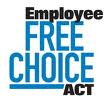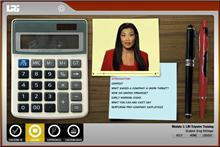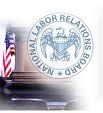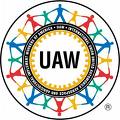 Labor Relations INK In this issue:
Labor Relations INK In this issue:
- EFCA Update
- Zoning, Walmart, and Union Abuse of Law
- Law Professor Lauds Union Salts
- Scoreboard, ULP Charge of the Month, Sticky Fingers and more…
EFCA Update  November stands to be a memorable moment for Big Labor. Most will think we are referring to the election, which could very well unseat enough Democrats that Big Labor’s Washington feeding frenzy will come to an abrupt halt. However, there is a perfect storm brewing that is more than just public reaction to health care reform and disastrous economic policies, beyond the Tea Party movement, beyond the disgust with the “embedding” of former union officials in key government posts. Keep in mind that Big Labor is a source of life blood for the Democrat party – millions of dollars of dues money and manpower spent on each election cycle. According to The Center for Responsive Politics, eight of the top ten all-time political contributors and five of the top ten biggest spending lobbyists are labor unions. This is all pretty much known and understood – it’s the way politics is played in Washington.
November stands to be a memorable moment for Big Labor. Most will think we are referring to the election, which could very well unseat enough Democrats that Big Labor’s Washington feeding frenzy will come to an abrupt halt. However, there is a perfect storm brewing that is more than just public reaction to health care reform and disastrous economic policies, beyond the Tea Party movement, beyond the disgust with the “embedding” of former union officials in key government posts. Keep in mind that Big Labor is a source of life blood for the Democrat party – millions of dollars of dues money and manpower spent on each election cycle. According to The Center for Responsive Politics, eight of the top ten all-time political contributors and five of the top ten biggest spending lobbyists are labor unions. This is all pretty much known and understood – it’s the way politics is played in Washington.  What is not so widely known is that on November 1st, the Financial Accounting Standards Board (FASB) ceases to take public comment on a new rule requiring that companies more accurately report liabilities they have from participation in multiemployer pension plans. Unless FASB is persuaded otherwise, the rule takes effect Dec. 15. Why is this significant? Washington Examiner columnist Mark Hemingway explains:
What is not so widely known is that on November 1st, the Financial Accounting Standards Board (FASB) ceases to take public comment on a new rule requiring that companies more accurately report liabilities they have from participation in multiemployer pension plans. Unless FASB is persuaded otherwise, the rule takes effect Dec. 15. Why is this significant? Washington Examiner columnist Mark Hemingway explains:
Under “last man standing” accounting rules, if five companies are in a plan and four go bankrupt, the fifth company is responsible for meeting the pension obligations for the employees of the other four companies. What this means is that companies with union labor often have pension liabilities that are several multiples higher than the pension expenditures they report — the Kroger grocery store chain shocked analysts last year when it disclosed its multiemployer pension liabilities more than doubled in a year to $1.2 billion. Ratings agencies such as Moody’s and Standard and Poor’s have been highlighting the lack of transparency in union pension plans. Now Wall Street wants union businesses to be upfront about their liabilities. FASB’s new rule could effectively wipe out the paper worth of many companies, especially in the trucking and construction industries. Once banks and creditors are aware of these staggering pension liabilities, it will make it nearly impossible for union businesses to get loans, credit lines or bonding. If forced to report their true liabilities, hundreds — perhaps thousands — of companies will scramble to get out from under their union obligations.
We have already reported on the dismal shape that these union pension funds are in, many of the largest in critical condition. When American workers finally understand that a) the pensions they believe they will receive may be “vapor,” and b) their company’s liabilities for such funds may put the very company’s existence into doubt, they are likely rethink the value of their union membership card. Now – stop just a minute and think this through. If the Democrats reach a similar conclusion about the American workforce, and see the potential for one of their largest sources of revenue to resemble a barren desert, how motivated may they become to “damn the torpedoes” and engage in lame duck session shenanigans? This could take several forms, including an attempt to make a last-gasp push for the Employee Free Choice Act, and a taxpayer-funded bailout of these defunct pension plans. Interestingly, Richard Trumka, head of the AFL-CIO, thinks the solution is a public takeover of the entire private sector! Since public sector unions are already strangling many state and municipal governments, one can only wonder where Mr. Trumka received his education in basic math, let alone economics. (Could it be the government/union controlled education system?) ********** Another Healthcare Strike  When over 100 nurses began a picket outside Oakland Children’s Hospital, and hundreds more failed to show up for work, Chief Nursing Officer for the hospital Nancy Shibata, RN, MSN, penned a letter chiding the CAN with being “out of step with both the economic realities facing Children’s Hospital Oakland, but also with the broader economic climate nationally,” and characterized the strike as being “reflective of the CNA’s inability to acknowledge and accept the changes that are occurring throughout the country related to wages and healthcare.” Shibata further lays out the details of the offers made during contract negotiations and compares the current terms with contracts bargained during an earlier, more stable economic climate, and appeals to the CNA to act reasonably to keep the hospital solvent. Knowing the CNA, it is reasonable to assume the appeal will fall on deaf ears. ********** BRAND NEW!
When over 100 nurses began a picket outside Oakland Children’s Hospital, and hundreds more failed to show up for work, Chief Nursing Officer for the hospital Nancy Shibata, RN, MSN, penned a letter chiding the CAN with being “out of step with both the economic realities facing Children’s Hospital Oakland, but also with the broader economic climate nationally,” and characterized the strike as being “reflective of the CNA’s inability to acknowledge and accept the changes that are occurring throughout the country related to wages and healthcare.” Shibata further lays out the details of the offers made during contract negotiations and compares the current terms with contracts bargained during an earlier, more stable economic climate, and appeals to the CNA to act reasonably to keep the hospital solvent. Knowing the CNA, it is reasonable to assume the appeal will fall on deaf ears. ********** BRAND NEW!  Many of our clients have benefited from our TripwireTM Training for supervisors and managers. Front line managers learn how to detect signs of union activity, often long before a petition is filed, and what to do about it. NOW – this valuable training is available online, as a part of our Online Active Interval Training system. In less than an hour, those who are in the best possible position to detect the early warning signs of union organizing will learn how to pick up on these subtle behavioral signs. Their skills will be honed through pre- and post-training questions, engaging lessons, and interactive experiences. And – the training can be reviewed as often as necessary to keep their senses sharp! Test drive the module today. Click here to get set up for a free 15-day trial. If you haven’t yet checked out our entire 8-module Online Active Interval Training system, click here. *********** Zoning, Wal-mart, and Union Abuse Of Law
Many of our clients have benefited from our TripwireTM Training for supervisors and managers. Front line managers learn how to detect signs of union activity, often long before a petition is filed, and what to do about it. NOW – this valuable training is available online, as a part of our Online Active Interval Training system. In less than an hour, those who are in the best possible position to detect the early warning signs of union organizing will learn how to pick up on these subtle behavioral signs. Their skills will be honed through pre- and post-training questions, engaging lessons, and interactive experiences. And – the training can be reviewed as often as necessary to keep their senses sharp! Test drive the module today. Click here to get set up for a free 15-day trial. If you haven’t yet checked out our entire 8-module Online Active Interval Training system, click here. *********** Zoning, Wal-mart, and Union Abuse Of Law  Pacific Legal Foundation attorney Timothy Sandefur writes this short piece exposing another little-known tactic by unions used to hamstring non-union competitors: zoning laws. Sandefur outlines how unions misuse the laws to protect their interests, preventing non-union companies from setting up shop in proximity with union stores, and sometimes keeping them from opening in a particular community altogether. In other abuses of private-interest lawmaking, unions have used city ordinances to force non-union stores in certain situations to carry more payroll than required. Thinly veiled in the name of “public interest,” the moves are again designed to allow union shops to stay competitive with non-union stores. Sandefur hints at the relationship between Big Labor and its political friends as the reason for such sustained abuse of the law:
Pacific Legal Foundation attorney Timothy Sandefur writes this short piece exposing another little-known tactic by unions used to hamstring non-union competitors: zoning laws. Sandefur outlines how unions misuse the laws to protect their interests, preventing non-union companies from setting up shop in proximity with union stores, and sometimes keeping them from opening in a particular community altogether. In other abuses of private-interest lawmaking, unions have used city ordinances to force non-union stores in certain situations to carry more payroll than required. Thinly veiled in the name of “public interest,” the moves are again designed to allow union shops to stay competitive with non-union stores. Sandefur hints at the relationship between Big Labor and its political friends as the reason for such sustained abuse of the law:
When government yields to activists who want to use zoning laws to forbid the opening of Wal-Marts, or health and safety regulations to increase the costs of non-union businesses, it isn’t serving the public interest, as required by the principles of due process of law — it’s acting out of pure political will; out of pure arbitrariness. Yet because courts refuse to treat economic liberty with the same seriousness that they accord other realms of liberty, such abuses continue, and the courts remain silent.
*********** AFL-CIO Targets Young Workers  The AFL-CIO recently announced it plans to step up its efforts to reach young people, so that they “know the value of collective action and be connected with unions.” AFL-CIO Secretary-Treasurer Liz Shuler explained to telephone press conference listeners,
The AFL-CIO recently announced it plans to step up its efforts to reach young people, so that they “know the value of collective action and be connected with unions.” AFL-CIO Secretary-Treasurer Liz Shuler explained to telephone press conference listeners,
I strongly believe the young worker outreach is the key to labor’s potential and we have to be creative and deliberate. With the economy being what it is, young workers feel disenfranchised and it’s up to us to take on this work and move it forward.
Teaming up with the American Federation of Teachers, the AFL-CIO aims at interjecting more union propaganda in America’s school systems. The result of a youth summit held this past summer lead to the establishment of 10 initiatives designed to coax more young workers into the AFL-CIO/Big Labor fold. ********** ULP Charge(s) Of The Month  The Southwest Regional Council of Carpenters out in California doesn’t seem to take “no” for an answer, even when “no” is coming from the National Labor Relations Board. These two ULPs, filed against 2 different locals in the region, charge the Carpenters with blocking job site gates, physically assaulting persons, causing property damage, spitting at people, and all in violation of prior settlement commitments (three different ones), even though the Regional Council already faces a contempt issue before the NLRB’s Contempt Division in Washington, D.C. Read the actual charge. ********** Law Professor Lauds Union Salts
The Southwest Regional Council of Carpenters out in California doesn’t seem to take “no” for an answer, even when “no” is coming from the National Labor Relations Board. These two ULPs, filed against 2 different locals in the region, charge the Carpenters with blocking job site gates, physically assaulting persons, causing property damage, spitting at people, and all in violation of prior settlement commitments (three different ones), even though the Regional Council already faces a contempt issue before the NLRB’s Contempt Division in Washington, D.C. Read the actual charge. ********** Law Professor Lauds Union Salts  During the Bush era, the NLRB attempted to thwart the use of union salts in organizing campaigns. Although there hasn’t been any apparent board action under the newly reconstituted Obama-era board, don’t be surprised to see some move to legitimize the tactic at some point. Michael Duff, a law professor at the University of Wyoming, is publishing an upcoming article in the Berkeley Journal of Employment and Labor Law most likely designed to grease the skids for such action. The article, titled “Union Salts as Administrative Private Attorneys General,” attempts to provide legitimacy to salts and salting activities by layering the tactic in a façade of legal-sounding terminology. His twist is to make salts appear to be undercover agents of the NLRB, using their charge filing tactics as a “general mechanism in aid of increased enforcement of the NLRA.” Duff contends that “the NLRB should not reject salting activity on ‘moral’ grounds.” It’s not hard to imagine where Duff’s morals are based, as he served for 11 years as a union shop steward prior to entering law school. If you want to waste some time to unravel his logic, download the entire article here. ********** Can’t Have It Both Ways
During the Bush era, the NLRB attempted to thwart the use of union salts in organizing campaigns. Although there hasn’t been any apparent board action under the newly reconstituted Obama-era board, don’t be surprised to see some move to legitimize the tactic at some point. Michael Duff, a law professor at the University of Wyoming, is publishing an upcoming article in the Berkeley Journal of Employment and Labor Law most likely designed to grease the skids for such action. The article, titled “Union Salts as Administrative Private Attorneys General,” attempts to provide legitimacy to salts and salting activities by layering the tactic in a façade of legal-sounding terminology. His twist is to make salts appear to be undercover agents of the NLRB, using their charge filing tactics as a “general mechanism in aid of increased enforcement of the NLRA.” Duff contends that “the NLRB should not reject salting activity on ‘moral’ grounds.” It’s not hard to imagine where Duff’s morals are based, as he served for 11 years as a union shop steward prior to entering law school. If you want to waste some time to unravel his logic, download the entire article here. ********** Can’t Have It Both Ways  It is fascinating that as union organizers continue to spout the Big Labor pabulum that “you are the union” in organizing campaigns across the country, labor leaders continue to shepherd union locals into mergers with other large locals. Rather than union members ending up with decentralized leadership close to their workplace, they end up with highly centralized top-down-style management of their affairs, often from as far away as across the entire North American continent. SEIU seems to remain the poster child for such arrangements, and in California, yet another three locals gave up their autonomy (and more workplace democracy) to throw themselves into a California super-local, the 40,000 member strong SEIU United Service Workers West. It was a similar ballooning of the huge SEIU United Healthcare Workers West, and the eventual dissatisfaction of that local’s leadership with control from SEIU International in Washington, that lead to the formation of the fledgling National Union of Healthcare Workers. Might the same eventually happen with the USW West? ********** NLRB “Insight”
It is fascinating that as union organizers continue to spout the Big Labor pabulum that “you are the union” in organizing campaigns across the country, labor leaders continue to shepherd union locals into mergers with other large locals. Rather than union members ending up with decentralized leadership close to their workplace, they end up with highly centralized top-down-style management of their affairs, often from as far away as across the entire North American continent. SEIU seems to remain the poster child for such arrangements, and in California, yet another three locals gave up their autonomy (and more workplace democracy) to throw themselves into a California super-local, the 40,000 member strong SEIU United Service Workers West. It was a similar ballooning of the huge SEIU United Healthcare Workers West, and the eventual dissatisfaction of that local’s leadership with control from SEIU International in Washington, that lead to the formation of the fledgling National Union of Healthcare Workers. Might the same eventually happen with the USW West? ********** NLRB “Insight”  In case you haven’t seen it yet, the U.S. Chamber of Commerce provides a great resource for keeping abreast of happenings at the National Labor Relations Board. The publication is titled “NLRB Insight.” The publication is a good summary of NLRB activity, and although it may be prudent to keep a closer eye on administration activity, particularly at the NLRB, this is a good document to keep on hand, and a good link to bookmark. As an INK subscriber, you will be notified anytime there is a board decision that could impact you. *********** SCORE BOARD
In case you haven’t seen it yet, the U.S. Chamber of Commerce provides a great resource for keeping abreast of happenings at the National Labor Relations Board. The publication is titled “NLRB Insight.” The publication is a good summary of NLRB activity, and although it may be prudent to keep a closer eye on administration activity, particularly at the NLRB, this is a good document to keep on hand, and a good link to bookmark. As an INK subscriber, you will be notified anytime there is a board decision that could impact you. *********** SCORE BOARD  Who are the winners (and losers) of the labor movement? Don’t guess, just check the LRI Scoreboard
Who are the winners (and losers) of the labor movement? Don’t guess, just check the LRI Scoreboard
View this month’s scoreboard (archives also located here).
Download a PDF of this month’s scoreboard
**********
UAW Members Upset at Leadership…Again  UAW members are once again upset that their union negotiated a two-tier wage plan and approved it without allowing them to vote on the issue. Never mind that without approval of the contract (with two-tier plan included), the plant would be closed, and another 1500 autoworkers without jobs. It was apparently calculated that such a two-tier plan was the only way that the Chevy Aveo could be built profitably, at least by a UAW-shackled plant. Some of the more interesting reading came from those who responded to one of the postings of the story, who suggested another way for GM to produce the car profitably would be to open a non-union facility. The Aveo is the only subcompact still built in the U.S., apparently due to the high union-driven labor costs associated with the American auto industry. ********** AFL-CIO’s Enhanced Online Tool Beware what information can be found about your business online. The AFL-CIO rolled out an improved version of a site originally launched in 2004, that uses powerful Google mapping tools and a database of information on over 400,000 U.S. businesses, to pin point those companies accused of mass layoffs, outsourced jobs, health and safety violations, and labor law violations. Some have suggested the site may help inspire voter turnout by union households, and Trumka states that the objective is aimed at forcing government leaders to prevent jobs from moving overseas. However, the hidden union objective may be to help identify companies that may be ripe for union organizing activity. Put in your zip code and see if your company shows up. *********** Stern Reveals True Colors
UAW members are once again upset that their union negotiated a two-tier wage plan and approved it without allowing them to vote on the issue. Never mind that without approval of the contract (with two-tier plan included), the plant would be closed, and another 1500 autoworkers without jobs. It was apparently calculated that such a two-tier plan was the only way that the Chevy Aveo could be built profitably, at least by a UAW-shackled plant. Some of the more interesting reading came from those who responded to one of the postings of the story, who suggested another way for GM to produce the car profitably would be to open a non-union facility. The Aveo is the only subcompact still built in the U.S., apparently due to the high union-driven labor costs associated with the American auto industry. ********** AFL-CIO’s Enhanced Online Tool Beware what information can be found about your business online. The AFL-CIO rolled out an improved version of a site originally launched in 2004, that uses powerful Google mapping tools and a database of information on over 400,000 U.S. businesses, to pin point those companies accused of mass layoffs, outsourced jobs, health and safety violations, and labor law violations. Some have suggested the site may help inspire voter turnout by union households, and Trumka states that the objective is aimed at forcing government leaders to prevent jobs from moving overseas. However, the hidden union objective may be to help identify companies that may be ripe for union organizing activity. Put in your zip code and see if your company shows up. *********** Stern Reveals True Colors  For years, Andy Stern, former president of the SEIU, supposedly fought for the little guy against the evils of the corporatists. Stern, often described as “unapologetic about targeting private equity firms” or “shaming business leaders,” now apparently wants to sit on the other side of the table, working on behalf of what one writer calls “organized labor’s historic enemy,” – wait for it – “private equity.” It was recently announced that Stern had been appointed to the board of SIGA Technologies, and awarded 25,000 stock options. Ron Pearlman and his private-equity firm MacAndrews & Forbes, are the largest shareholders in SIGA Technologies. It also doesn’t seem to matter to Stern (or to the Obama administration, for that matter), that his new gig creates a conflict of interest with his position on the Obama’s deficit commission. SIGA, as a biowarfare defense contractor, is in direct competition with other public priorities for federal dollars, as savings from cuts the panel recommends to social programs could be used to fund defense and homeland security spending. The irony does not seem to bother Stern. Looking back at his history of his dealings with Pearlman, particularly the between the SEIU and several of Pearlman’s companies (such as AlliedBarton). It appears Stern has been feathering his nest for years, at the expense of the labor movement he purported to champion. It seems that Stern has always been a champion of, well… Stern! ********* Sticky Fingers Current charges or sentences of embezzling union officials:
For years, Andy Stern, former president of the SEIU, supposedly fought for the little guy against the evils of the corporatists. Stern, often described as “unapologetic about targeting private equity firms” or “shaming business leaders,” now apparently wants to sit on the other side of the table, working on behalf of what one writer calls “organized labor’s historic enemy,” – wait for it – “private equity.” It was recently announced that Stern had been appointed to the board of SIGA Technologies, and awarded 25,000 stock options. Ron Pearlman and his private-equity firm MacAndrews & Forbes, are the largest shareholders in SIGA Technologies. It also doesn’t seem to matter to Stern (or to the Obama administration, for that matter), that his new gig creates a conflict of interest with his position on the Obama’s deficit commission. SIGA, as a biowarfare defense contractor, is in direct competition with other public priorities for federal dollars, as savings from cuts the panel recommends to social programs could be used to fund defense and homeland security spending. The irony does not seem to bother Stern. Looking back at his history of his dealings with Pearlman, particularly the between the SEIU and several of Pearlman’s companies (such as AlliedBarton). It appears Stern has been feathering his nest for years, at the expense of the labor movement he purported to champion. It seems that Stern has always been a champion of, well… Stern! ********* Sticky Fingers Current charges or sentences of embezzling union officials:
| Keith Hart | BCTGM | $13,904 |
| Woodrow Anderson | GMP | $2,250 |
| Kevin McGee | AFGE | $4,800 |
| Keith Knight | USW | $43,500 |
| Jonathan Steven Deutsch | CLC | $750,000 |
| Stephen Arena and David Caivano | IUANPW | $375,000 |




